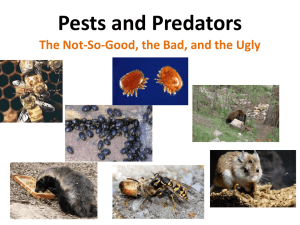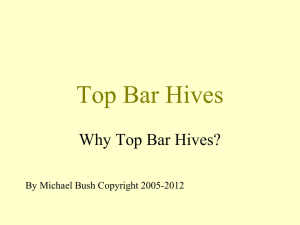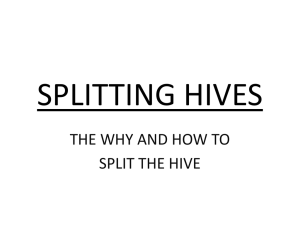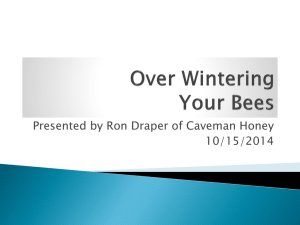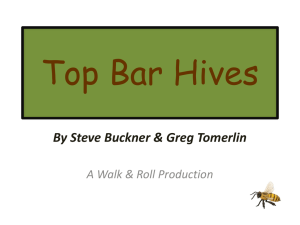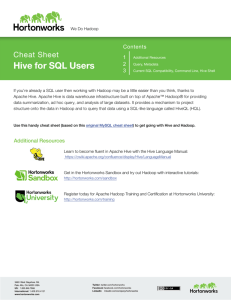Monitoring Hive Weight, Temperature, and Sound: The
advertisement
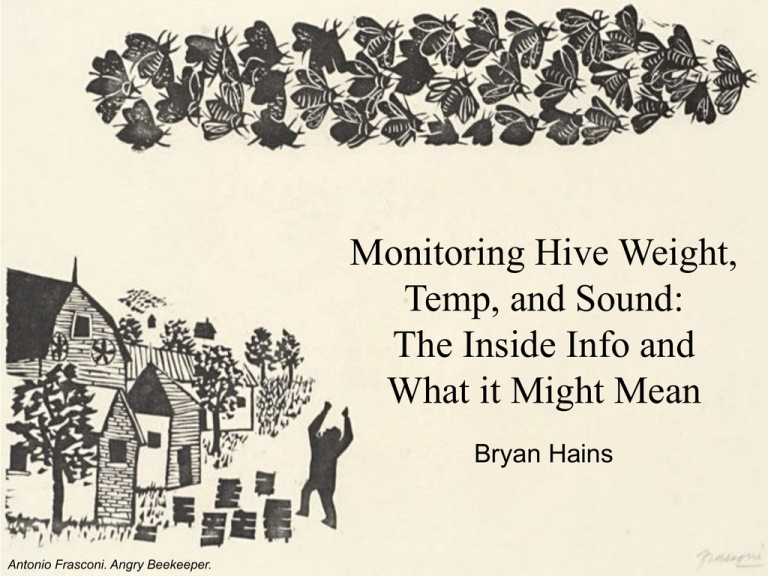
Monitoring Hive Weight, Temp, and Sound: The Inside Info and What it Might Mean Bryan Hains Antonio Frasconi. Angry Beekeeper. 2 Special thanks to: • Paul Vonk, Center for Honeybee Research • South Carolina Beekeepers Association • NASA HoneyBeeNet Thanks to SMBG for Helping to interpret the data! 3 Background 4 Past 5 Past and Present 6 About HiveTool.net • Open-source • Goal is to produce software tools to monitor, manage and research bees and honey production • Uses off the shelf, consumer grade (low cost) hardware • All the data is available for download by anyone at anytime for analysis • Feeds data to NASA’s HoneyBeeNet 7 Hive Locations (17) 8 The Setup 9 Hardware and Software • IBM Lenovo X60 laptop circa 2006 $90 ebay – 1.6 GHz, 80GB HD, 1GB RAM – Dual boot windows xp, unix • • • • • • • • Lubuntu lightweight Ubuntu unix Adam equipment CPWplus 200 scale TEMPer2 USB thermoprobe Kinobo Akiro USB 2.0 microphone Extension cord USB hub, extender, misc connectors Hivetool software, sox, etc Plywood free $160 amazon $16 ebay $19 amazon $5 $26 free free ====== $316 TOTAL PROJECT COST 10 11 Hardware Configuration Inside Outside Hive Weatherproof Electronics Enclosure Linux-based laptop or Pi TEMPer2 Ambient USB Hub 1 RS-232 to USB Adapter 2 3 4 Power 120 VAC Scale 12 VDC RS-232 TEMPer2 Hive Controller Microphone Hive Platform (Load cells) 12 Outside and Inside the Hive 13 What the Software Does • At prespecified intervals, crontab: – Runs shell and perl scripts to capture hive data – Updates graphs – Emails computer status and daily graph – Backs up data and store offsite • Web pages updated in real time and served to the world Update long graphs Archive data Email update 6 am Weigh noon Audio sampling 6 pm midnight 14 System Output 15 What Can be Learned? and What Does it Mean? 16 A Typical Day in the Life Broodnest temp Hive weight Ambient temp Midnight Noon Midnight 17 Example: Pollen vs. Nectar Flow Data Log Data Log 18 Example: Cleansing or Orientation Flight • At around noon on two days (12/27/13, 1/7/14), a sudden drop in hive weigh was noticed • From a 0.2 lb drop (62.7 – 62.5), a rough estimate of the number of bees leaving can be calculated; assuming 3000 bees per pound, approximately 600 more bees were flying • Is it possible to calculate hive strength and egg laying ability of the queen? 19 Example: Cleansing or Orientation Flight bchains@doppelbienen: 2014/03/30 13:40 + 105.2 lb 2014/03/30 13:45 + 105.2 lb 2014/03/30 13:50 + 105.2 lb 2014/03/30 13:55 + 105.1 lb 2014/03/30 14:00 + 105.0 lb 2014/03/30 14:05 + 104.9 lb 2014/03/30 14:10 + 104.7 lb 2014/03/30 14:15 + 104.8 lb 2014/03/30 14:20 + 104.9 lb 2014/03/30 14:25 + 105.0 lb 20 Example: Robbing? Example: Dehydration and Respiration in High Humidity • From midnight- 8 AM the hive gained weight (~0.2 lb = 3 oz = 90 mL) • Source is probably fog and/or condensation from bee respiration due to lowered dewpoint 21 22 Example: Rain and Cold Spell Example: Growing Colony (Eucalyptus Flow?) Daily Midnights 23 24 Example: Untreated Varroa Infestation • Total hive weight is dropping • Treated with half dose MAQS on Sep 15, and Nov 10 – ineffective Daily Midnights 25 Analysis of Hive Sounds 26 Audio Sampling • • • • • • Microphone placed in center of broodnest Frequency range: 100–16000 Hz Sound sampled at 16k Hz for 10 sec, every 2h from 7am-7pm (depending on season) 1000 Hz lowpass filter to reduce noise Spectrogram updated q 2h on day’s events Ogg format used to archive sounds Charles Butler. 'The feminine monarchie or a treatise concerning bees, and the due ordering of them'. Oxford, 1609. [NLS shelfmark: MRB.13] 27 Audio Spectrogram • “Looking for” queen tooting/piping (350-550 Hz = G sharp), quacking (200-350 Hz), regular buzzing, disturbed sounds, tapping feet 28 Audio Example: Circadian Activity Typical warm and sunny day 7 am 7 pm 29 Audio Example: Queen Piping 30 Audio Example: Waggle Dance Waggle dance 31 Audio Example: Cold Foggy Day 32 Audio Example: Raindrops What I’ve Learned • Bees are incredible creatures • Awesome insight can be obtained by simply weighing the hive • This can be done cheaply • Daily activity varies dramatically per nectar, pollen, weather • I’m more in touch with my bees, but inside the hive less • We need more hive monitoring! Join me! Bryan Hains bryan.hains@gmail.com Beebox: http://99.47.64.18:8080/ Doppelbienen: http://99.47.64.18:8081/ 33 34 Appendix 35 Next Steps • Real-time audio streaming and analysis, email alerting for weight changes (swarming) • Video quantification of traffic? • Autonomous hive computer: – Raspberry Pi B: solar, wifi 36 Example: Spring Nectar Flow (GA003) • Adding and removing honey supers is best managed by knowing the beginning and end of nectar flows • This hive experienced a 90 pound weight gain in just three weeks Date Day of Year Weight Delta Weight 2012/03/12 72 140.1 1.3 2012/03/14 74 143.2 2.3 2012/03/16 76 133.2 4.7 2012/03/18 78 136.7 3.6 2012/03/20 80 151.1 7.7 2012/03/22 82 159.2 3.3 2012/03/24 84 165.0 2.5 2012/03/26 86 178.0 8.8 2012/03/28 88 189.5 9.1 2012/03/30 90 202.5 4.7 2012/04/01 92 206.5 3.4 2012/04/03 94 210.4 0.9 22 Day Total Weight Gain 89.6 37 Example: Untreated Varroa Infestation 38 Predictive Mathematical Models ΔHive Weight = Weight Gain - Weight Loss [1] Weight Gain = Nectar + Pollen + water + brood growth + bee growth + landings + FOD [2] Weight Loss = Evaporation + Metabolic activity (respiration) + bee deaths [3] + waste elimination + take offs Evaporation = (Nectart0)*ER + (Nectart-1)*2/3*ER + (Nectart-2)*1/3*ER [4] where Evaporation Rate ~ (Water Content * Temperature * Wind) (ER) Humidity FOD (Foreign Object or Debris): Rain, animals, branch, rock [5] 39 Audio Example: Walking Around? • Walking around after dark 40 Audio Example: Leaf Blower • Bzzzz



